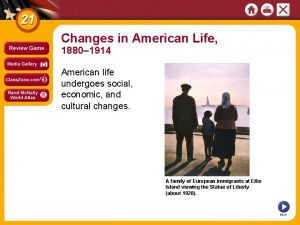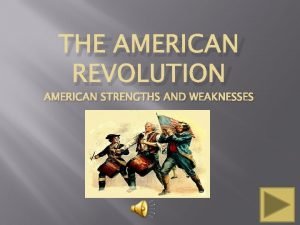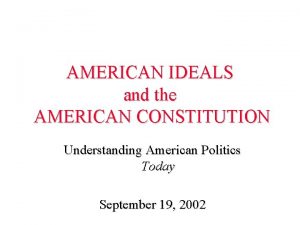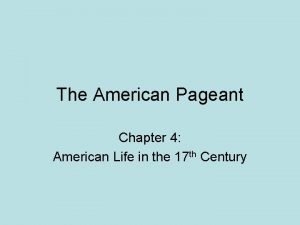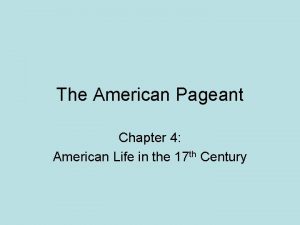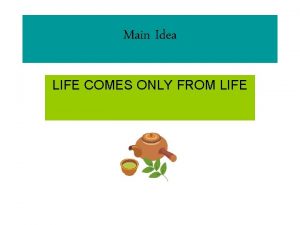th American Life in the 17 c Life
























- Slides: 24

th American Life in the 17 c

Life in the Southern Colonies

Indentured Servitude Headright System Indentured Contract, 1746

Indentured Servitude Headright System: § Each Virginian got 50 acres for each person whose passage they paid. Indenture Contract: § 5 -7 years. § Promised “freedom dues” [land, £] § Forbidden to marry. § 1610 -1614: only 1 in 10 outlived their indentured contracts!

Virginia: “Child of Tobacco” Tobacco’s effect on Virginia’s economy: § Vital role in putting VA on a firm economic footing. § Ruinous to soil when continuously planted. § Chained VA’s economy to a single crop. Tobacco promoted the use of the plantation system. § Need for cheap, abundant labor.

Frustrated Freemen Late 1600 s large numbers of young, poor, discontented men in the Chesapeake area. § Little access to land or women for marriage.

Nathaniel Bacon’s Rebellion: 1676 Led 1, 000 Virginians in a rebellion against Governor Berkeley Nathaniel Bacon Governor William Berkeley § Rebels resented Berkeley’s close relations with Indians. Ø Berkeley monopolized the fur trade with the Indians in the area. Ø Berkley refused to retaliate for Indian attacks on frontier settlements.

Bacon’s Rebellion: 1676

Bacon’s Rebellion Rebels attacked Indians, whether they were friendly or not to whites. Governor Berkeley driven from Jamestown. They burned the capital. § Rebels went on a rampage of plundering. Bacon suddenly died of fever. Berkeley brutally crushed the rebellion and hanged 20 rebels.

Results of Bacon’s Rebellion It exposed resentments between inland frontiersmen and landless former servants against gentry on coastal plantations. § Socio-economic class differences/clashes between rural and urban communities would continue throughout American history. Upper class planters searched for laborers less likely to rebel BLACK SLAVES!!

17 c Population in the Chesapeake WHY this large increase in black popul. ? ?

The Atlantic Slave Trade

Goods Traded with Africa

The “Middle Passage”

Colonial Slavery As the number of slaves increased, white colonists reacted to put down perceived racial threat. § Slavery transformed from economic to economic and racial institution. § Early 1600 s differences between slave and servant were unclear. By the mid-1680 s, black slaves outnumbered white indentured servants.

Colonial Slavery Beginning in 1662 “Slave Codes” Barbados Code § Made blacks [and their children] property, or chattel for life of white masters. § In some colonies, it was a crime to teach a slave to read or write. § Conversion to Christianity did not qualify the slave for freedom.

Slave Fighting Back • NY Slave Revolt (1712) uprising 2 dozen slaves, results in death of 9 whites and execution of 21 blacks • South Carolina Slave Revolt (Stono River 1739) roughly 100 slaves attempt to reach Spanish Florida, killing whites along the way, stopped by local militia

Southern Society • Social Classes – Great Planters: dominate politics such as the House of Burgesses; at first hardworking and businesslike – Small Farmers: largest social group; might have a slave – Landless Whites: most former indentured servants – Indentured Servants – Black Slaves

Way of Life • • • Rural, few cities professional class slow to emerge waterways main transportation family burial plots Good soil, easy to grow crops Education sparse, schools expensive; if wealthy tutors – William and Mary College 1693

Life in the Northern Colonies

Characteristics of New England Settlements Low mortality average life expectancy was 70 years of age. Many extended families. Average 6 children per family. Average at marriage: § Women – 22 years old § Men – 27 years old.

Way of Life Authoritarian male father figures controlled each household. Wife abusers would be punished Most farmers Family center of life; children learn obedience Divorce and premarital pregnancy rare Layout towns; over 50 families required Elem. Edu. Harvard est. 1636 Church most important!!!!

Salem Witch Trials • 1692 -1693 Colony of Massachusetts • Launched with group of adolescent farm girls claimed to be bewitched by older women in town • Most were educated, wealthy women landowners who were never married or recently widowed • 150 people arrested… • 26 brought to trial… • ALL convicted… 19 hung • 1 man was stoned to death to get a confession

Population Comparisons: New England v. the Chesapeake
 Hình ảnh bộ gõ cơ thể búng tay
Hình ảnh bộ gõ cơ thể búng tay Bổ thể
Bổ thể Tỉ lệ cơ thể trẻ em
Tỉ lệ cơ thể trẻ em Voi kéo gỗ như thế nào
Voi kéo gỗ như thế nào Tư thế worm breton
Tư thế worm breton Chúa yêu trần thế alleluia
Chúa yêu trần thế alleluia Môn thể thao bắt đầu bằng chữ f
Môn thể thao bắt đầu bằng chữ f Thế nào là hệ số cao nhất
Thế nào là hệ số cao nhất Các châu lục và đại dương trên thế giới
Các châu lục và đại dương trên thế giới Công thức tính thế năng
Công thức tính thế năng Trời xanh đây là của chúng ta thể thơ
Trời xanh đây là của chúng ta thể thơ Mật thư tọa độ 5x5
Mật thư tọa độ 5x5 101012 bằng
101012 bằng Phản ứng thế ankan
Phản ứng thế ankan Các châu lục và đại dương trên thế giới
Các châu lục và đại dương trên thế giới Thể thơ truyền thống
Thể thơ truyền thống Quá trình desamine hóa có thể tạo ra
Quá trình desamine hóa có thể tạo ra Một số thể thơ truyền thống
Một số thể thơ truyền thống Cái miệng nó xinh thế
Cái miệng nó xinh thế Vẽ hình chiếu vuông góc của vật thể sau
Vẽ hình chiếu vuông góc của vật thể sau Biện pháp chống mỏi cơ
Biện pháp chống mỏi cơ đặc điểm cơ thể của người tối cổ
đặc điểm cơ thể của người tối cổ V cc
V cc Vẽ hình chiếu đứng bằng cạnh của vật thể
Vẽ hình chiếu đứng bằng cạnh của vật thể

























